 General
General  General Archive
General Archive  64 Since '64: Top Players of Cleveland's Title Drought Era: Rd 1, Pt 3
64 Since '64: Top Players of Cleveland's Title Drought Era: Rd 1, Pt 3
For those tardy to this little dance, 64 Since '64 is The Cleveland Fan's latest bracket-style tournament, matching up the top Indians, Browns, and Cavs players of the last 45 years in hopes of honoring those who did the most to make Cleveland sports watchable during an era fraught with heartbreak. Many fans have already voted, and the first round looks like a cakewalk for most of the higher seeds, but in this week's regional breakdown, Jeff Ellis and Andrew Clayman will be discussing a few of the tighter match-ups in the tourney, including a cornerback tete-a-tete and a too-close-to-call battle between Dennis Eckersley and Doug Jones.
Bracket Breakdown, Round 1, Part 3
By Andrew Clayman & Jeff Ellis
For those tardy to this little dance, 64 Since ’64 is The Cleveland Fan’s latest bracket-style tournament, matching up the top Indians, Browns, and Cavs players of the last 45 years in hopes of honoring those who did the most to make Cleveland sports watchable during an era fraught with heartbreak. Many fans have already voted, and the first round looks like a cakewalk for most of the higher seeds, but in this week’s regional breakdown, Jeff Ellis and I will be discussing a few of the tighter match-ups in the tourney, including a cornerback tete-a-tete and a too-close-to-call battle between Dennis Eckersley and Doug Jones.
Click Here to Vote In the 64 Since '64 Bracket, If You Haven't Already
So, on we go to the Red & Blue Regional. If you missed one the earlier regional breakdowns, and you find yourself hopelessly bored and pining for more, you can check out the Orange & Brown Regional and the Wine & Gold Regional match-ups. Only one more regional breakdown after this. Then we’re on to Round 2!
Round 1, Red & Blue Regional
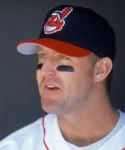
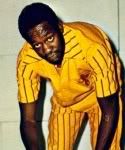
#1 Jim Thome vs #16 Jim Chones
ANDREW CLAYMAN: In a city 45 years removed from its last taste of sports glory, villains tend to remain villains for the long haul, never given the chance to shake free of whatever scarlet letter the fans tattooed on them. In Jim Thome’s case, that letter is a big fat “G” for “greedy” (not Gatorade, sadly). Fans were still booing the man this season as a member of the White Sox, seven years removed from his free agent departure to Philadelphia. Considering that (a) everyone seems to agree that the Dolans are cheap skates, and (b) keeping Thome would have made very little sense on a team trying to build a new, younger core in 2003, it’s hard to reason why Tribe fans still haven’t found the will to forgive Big Jim and appreciate the fact that he will likely go into the Hall of Fame as a Cleveland Indian. He ranks 3rd in team history in OBP, 3rd in slugging, 5th in runs, 2nd in RBIs, 1st in walks, and of course, 1st in home-runs. He has only had nice things to say about his days in Cleveland since leaving. But, for the haters who must hate unconditionally, your alternative in this #1 vs #16 matchup is former Cavalier center Jim Chones, who played 5 seasons in Richfield in the late ‘70s, averaging a very productive 14 PPG and 10 rebounds during that span. Between 1976 and 1979, Big Jim (the original) didn’t miss a single regular season game, but the games he missed due to injury in the 1976 playoffs helped derail the run of the Miracle of Richfield team. Chonesy went on to be a TV commentator for the Cavs during their playoff runs in the ‘80s and ‘90s. JEFF ELLIS: Outside of his time in the broadcast booth, my biggest memory of Jim Chones was how my father always talked about him, making it sound like his injury single handedly cost the 1976 Cavaliers a championship. Chones was the definition of a solid center, but it was the man who backed him up, Nate Thurmond, who eventually got his number retired. Jim Thome, on the other hand, will likely have his #25 hanging among the retired Hall of Fame digits at Progressive Field some day. As Andy discussed above, Thome was one of the most dominant hitters in Tribe history. And unlike many other players who’ve skipped town, Thome never felt like a traitor to me. He wanted his six year deal and to finish his career here, but the rebuilding Indians weren’t biting. And so it goes. When his career comes into context, Thome won’t necessarily be a first ballot HOF guy (his notorious slow starts actually kept him out of a lot of All-Star Games, and his era casts a shadow on everyone), but he’ll get there for his consistency and his character— Jimmy put 10 of his nieces and nephews through college and has been voted among the friendliest guys in baseball by his peers. I think we can bury this particular hatchet and quickly move Mr. Thome along to round 2.
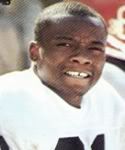
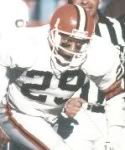
#8 Frank Minnifield vs #9 Hanford Dixon
AC: They made up the best cornerback tandem in football, and also the one ironically victimized by the most famous drive in NFL history. In any case, Frank Minnifield and Hanford Dixon were always two sides of the same coin, which makes it all the more difficult to separate them and pit them against one another 20 years after the fact. As current voting shows, the fans will always favor the “Top Dawg” Dixon, but this probably has little to do with a comparison of on-field performances. Since he’s generally credited for creating the canine motif that’s now synonymous with the Browns franchise, Hanford has a true legacy in Cleveland, and he’s carried that out through his work on radio and TV. By comparison, Minnifield has kept a low profile post-football, running a construction company in Kentucky. Facts being facts, though, Frank was the co-creator of the Dawg Pound, and he was also a superior cornerback during the two players’ late ‘80s heydays. Quicker and harder hitting, Minnifield made 4 Pro Bowls to Dixon’s 3, and was named to the NFL All Decade Team of the 1980s. At the very least, the Top Dawg should be feeling a little more heat from his old tag team partner in this vote.
JE: Agree whole heartedly. I know Hanford is the bigger name in Cleveland lore, but let’s be honest, Minnifield is just as good if not better. They both gave us our beloved Dawg Pound, so no edge to be found there. As mentioned, Frank “out Pro-Bowled” Hanford 4-3, but Dixon actually made two All Pro teams to Frank’s one. Minnifield’s very impressive place on the All-Decade Team might give him the tiebreaker then, but when you’re talking defense, a lot of your work can’t be quantified. When these two played together, it was Hanford who racked up more interceptions, but Minnifield was generally regarded as the tougher match-up for opposing receivers. Amusingly, some stat sites even include Dixon in Minnifield’s “5 Similar Players” category, and vice versa. Hanford’s going to win this one, but on paper, it looks more like a toss up.
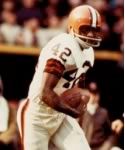
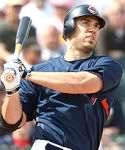
#4 Paul Warfield vs #13 Travis Hafner
AC: Since it’s fairly obvious that Warfield is going to win this game in a runaway, I might as well designate myself as the official devil’s (or Pronk’s) advocate. Exhibit A: A lot of Paul Warfield’s Hall of Fame credentials were earned as a member of the Miami Dolphins. He was a 3-time Pro Bowler in Cleveland, 5-time in Miami, and he only ranks 14th in Browns history in receptions, behind the likes of Eric Metcalf and Dennis Northcutt. Exhibit B: Travis Hafner had one of the best 3-year spans in Indians history, crushing 103 HRs, driving in 334 runs, and hitting about .308, with an OPS over 1.000. Pronk still ranks 7th in team history in slugging percentage and 10th in OPS, despite the severe dropoff of his past three seasons. He’s also been intentionally walked more times than anyone besides Jim Thome, proving that teams certainly feared him. Hafner finished in the top 8 in MVP voting twice, but amusingly, has never made an All-Star team, and the way it looks, probably never will. I feel like my case is starting to fall apart, so the defense rests.
JE: Like Carlos Baerga before him, Travis Hafner’s star may have shined a bit too bright, a bit too fast. While Carlos’ decline is usually blamed on excessive partying and poor conditioning, Pronk’s is the topic of even less flattering speculation. Was it the juice? The lingering shoulder problem? His decision to get married (everyone knows a high OPS goes hand in hand with bachelordom)? Whatever the reason, Hafner hasn’t rediscovered the magic that made him a huge run producer earlier this decade—a 3 year-span in which he helped Clevelanders forget the ghosts of Thome, Ramirez, and Belle. To his credit, Pronk also signed a long term, under-market value deal, which is admittedly way over-market now, but nonetheless. As for Paul Warfield, I have to disagree with Andy. Comparing Warfield’s receptions to the all-time Browns list would be like saying Tris Speaker wasn’t such a great Indian, since Mark Whitten hit more homers. It was a different game then and played a different way. Six of Warfield’s top ten seasons happened in Cleveland, including his best season and his third, fourth, and fifth best years. He made an impact right out of the gate-- a local boy who went to OSU and was taken by the Browns in round one. In 1969, coming off back-to-back All Pro seasons, Warfield was sent to Miami for Mike Phipps—a move that remains one of Art Modell’s lower moments among many. Using FootballReference.com’s new metric, Paul Warfield ranks as the 195th best player since 1950 (Mike Phipps falls in at 2,058). And as a Hall of Famer, he easily eclipses Hafner’s brief run of greatness.
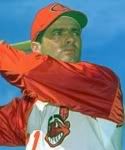

#5 Rocky Colavito vs #12 Bingo Smith
JE: Okay, I’m going first this time. I really feel like Bingo Smith is a guy whose numbers don’t do him justice. He was well known for his long distance shooting during his career, but as there was no 3-point stripe at the time, he was deprived of putting up some possible 20 PPG seasons during his prime. With those kind of numbers on his side, I think he might have stood a chance in this match-up, but then again, it’s pretty hard to beat a man who’s as much a local icon as a ballplayer. We all know about the Curse of Rocky Colavito, as made famous by Terry Pluto. Rocky obviously had great success is Cleveland during both his stints with the Tribe, but even outside the Curse itself, he did the franchise some long-term disservices. The cost to reacquire him in 1965 ended up being future Hall of Fame pitcher Tommy John, as well as Tommie Agee, who ended up winning the Rookie of the Year after the deal. Colavito put up excellent numbers coming back to Cleveland, but it’s hard to argue that his return was particularly helpful to the development of the team on the whole, especially as they were building toward being younger and more competitive in the late ‘60s. Anyway, Rocky’s got himself a win here, but I really think this game ought to be tighter. AC: Indeed, Bobby “Bingo” Smith was the true face of the Cavaliers first era; a steady presence during the expansion team’s turbulent ups and downs in the 1970s. The 6’5” guard was on the roster for the Cavs’ 15-67 inaugural season, as well as their stunning 1976 Eastern Conference Finals appearance. During his decade long career in the wine and gold, he was good for 12 to 16 points per game (sans triple line, as Jeff mentioned), and he was always a fan favorite, adding plenty of character to a team that wasn’t always easy to love. In some ways, he was the Cavs’ Rocky Colavito. Although, as the votes indicate so far, there’s still nobody who can knock the Rock. My dad’s (and many other dads) favorite player, Colavito was a huge star in Cleveland in the late ‘50s before taking his 40+ HRs and 100+ ribbies to Detroit in 1960 (notice that Harvey Kuenn failed to make this tournament). Appropriately, Rocky returned to Cleveland in 1965—the dawning of the title drought era. He proved he could still swing the stick that year (.287, 26 HRs, 108 RBIs), but that was his last hurrah really. The Rock was soon a relic, finishing his career as a pinch hitter for the White Sox and Yankees. Rocky in pinstripes… a sight to be forgotten. All things considered, Colavito’s best days were long before the post ’64 era, so his #5 seed might even be a tad friendly.

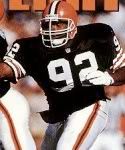
#3 Mark Price vs #14 Michael Dean Perry
JE: How good would an in-his-prime Mark Price look on the current Cavs? No disrespect to Mo Williams, but Price could do it all from the point guard spot-- a dead-eye 3 point shooter who retired as the team’s steals leader, assists leader, and the top foul shooter in NBA history. A legitimate case could be made that he was the most underrated player of his era. In 1988-89, Price even became the first player not named Bird to shoot 90% from the line, 50% from the field, and 40% from the outside. During roughly the same time period, the Cleveland Browns were starting their post AFC Championship decline, staying afloat with a defense anchored by Eric Turner and Michael Dean Perry. Andy can cover Perry’s statistical chops if he wants, but the one thing most worth remembering is the legendary MDP—the McDonalds burger that was named for Perry and only found in the Cleveland area. It was basically a Big Mac with extra bacon and three patties instead of two (by the looks of things, Michael Dean approved). Candy bars is one thing, but how many of our sports stars have had their own burger? Sadly, in the ultimate act of betrayal, Perry now owns his own Subway affiliate. So while I think Price should and will win, I only wonder if some fans of the MDP might let their Pavlovian responses impact their voting. AC: How could I forget the MDP?! Anyway, random as this match-up might seem, there was some thought put into it. Admittedly, that thought involved nothing beyond the funny image of the little choir boy Price lining up against the 300 pound Perry, but hey, it’s amusing, no? Pre-LBJ, Price was arguably the most popular Cav of all-time. Aside from being one of the great free throw shooters in history, as Jeff mentioned, he was also a phenomenal, cerebral point guard, both as a scorer and distributor. One of four Cavs from the Lenny Wilkens era in this tournament, Price is still the team’s all-time leader in assists and three pointers. He also ranks second in steals and fifth in points. On the other end, it’s a stretch, but you could call Michael Dean Perry the point guard of the Browns defense in the ‘90s, which actually had some fine years during the dreaded Bellichick era (whatever happened to that guy, anyway?). Perry is fourth in team history in tackles and made 5 Pro Bowls (often as the Browns’ sole representative). He also started the trend of the Broncos inexplicably signing every former Browns defensive lineman. Pretty sure Price wins this one, using his quickness to run circles around Perry and his beloved MDP.

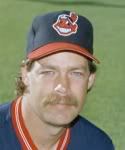
#6 Dennis Eckersley vs #11 Doug Jones
AC: Finally, a close vote! If we were merely comparing these guys for their career accomplishments as closers, Eck would probably take it by a 99-1 mark. But this is a Cleveland-centric poll, meaning we can only look at Eckersley as the up-and-coming starting pitcher in the late '70s who probably shouldn’t have introduced his wife to Rick Manning. His opponent is the Tribe’s greatest closer without a World Series blown save on his resume, Doug Jones. While Jones clearly takes the facial hair prize over the yet-to-be-mustachioed Eck, the stats show an even battle. Jones, who didn’t stick in the Big Leagues until he was 30, played 6 seasons for a very bad Indians team, making the All-Star team in 1988, ’89, and ’90, and eventually setting the team record for career saves (later broken by Bob Wickman, not pictured). Eckersley’s time in Cleveland was far too short—three seasons in his early 20s. But he was already very good, peaking with an All-Star 1977 season highlighted by a 12 K no-hitter. He still ranks 4th in team history in K/9 IP, and 9th all-time in WHIP. I would have voted Eck, but I give it to Jones for returning to Cleveland and recording one extra save in 1998 to secure his legacy.
JE: We all know about the dominant Hall of Famer Dennis Eckersley, but Doug Jones was an important trend-setter for the Tribe. I like to think of him as the man who set the standard for the slow-ball closers in Cleveland, including Steve Olin, Joe Blow, and Wicky. An intriguing fact about Jones; he appeared in only one less All-Star Game then Eck (by a 6 to 5 count)! In fact, if Jones had broken into the majors quicker, he likely would have surpassed Eckersley in that department, and could very well have ended up among the all-time leaders in saves. As for Eck, he was great in his short Cleveland run— All-Star, Rookie of the Year, signs of dominance-- but in the tradition of the time, the Tribe made the wrong choice and traded the 23 year-old when a certain situation arose. Anyway, even though Eckersley clearly had the better career, I too vote for Jones for his impact on the closer role in Cleveland.
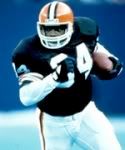
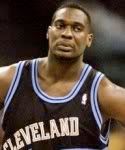
#7 Kevin Mack vs #10 Shawn Kemp
JE: Before he came to Cleveland, Shawn Kemp was my favorite NBA player. I even remember thinking up a trade of Terrell Brandon for Kemp in my head before the deal actually occurred. He was arguably the Cavs’ first real superstar, and upon his arrival, he put up big numbers. Surrounded by an interesting cast of All-Rookie performers (Brevin Knight, Z, Ced Henderson, and the original Derek Anderson), Kemp and the Cavs were a team on the rise. Then the lock-out happened and Kemp kept busy with food, drugs, and child production—perhaps the only exercise he was getting. Shawn’s explosive days were soon done and so was any hope for those late ‘90s Cavs teams. Kemp’s opponent in this match is Kevin Mack, yet another player the Browns got in the supplemental draft (Minnifield and Kosar arrived the same way). He hit like a “Mack truck” and most people thought he was actually going to be the better of the backs Cleveland had, but it never quite worked out. Drugs and lack of focus cut his career short and left us to wonder what might of have been. That said, Mack should win for his greater impact in Cleveland during the Browns ‘80s hey day, but I got to be honest, I voted Kemp for pure sentimentality. Somebody had to.
AC: With these two guys, it’s all about power. Kevin Mack basically defined the idea of the power fullback for me in the ‘80s, dragging tacklers and steamrolling over defensive backs. Statistically, he peaked in his rookie season, 1985, when he and Earnest Byner both ran for 1,000 yards. Mack never did it again, but that was more due to injuries and personal issues keeping him out of the lineup. He made the Pro Bowl in ’85 and ’87, and he remains the Browns 5th all-time leading rusher and 4th in career touchdowns. He’s squaring off here with a man who helped define the modern power forward for me in the ‘90s, the uber athletic Shawn Kemp. Less-than-loved as the chubbier Reign Man of his 3-year Cleveland stint, he still was a force inside, averaging right around 19 points and 9 boards over that span as the veteran leader of a very young squad. Since we’re all confessing to our shameful appreciation for Kemp, I admit I am also a member of Reignman Fan’s Anonymous, although I’ve managed to stay clean for over a decade with very little effort. This explains why I had no hesitation in voting for Kevin Mack. Do yourself a favor and watch #34 run in one of the old Youtube clips of the ‘80s Browns. He was a special back.
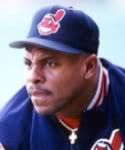
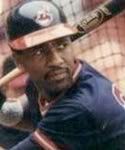
#2 Albert Belle vs #15 Joe Carter
JE: Albert Belle was also my favorite player when he was in Cleveland. I know everyone talks about how great a pure hitter Manny was, but for my money, the best hitter I saw on those 1990s teams was #8. In his prime, Belle became the fourth hitter in MLB history to have 8 straight seasons of 20 HRs and 100 RBIs, joining Jimmie Fox, Babe Ruth, and Lou Gehrig. He was also a stolen base threat early in his career, stealing double-digit bases multiple times. People would knock his defense, but his glove was above average according to every metric out there. If not for his hip issues, Belle would have gone down (statistically anyway) as a first ballot Hall of Famer. Joe Carter, meanwhile, was the Belle of the ‘80s-- the power hitter who also had surprising speed. The difference is that Carter never had a batting average approaching Belle’s, and his defense was so bad that he was shifted from OF to 1B/DH. Like Belle, he was a 5-time All-Star, but in their peak years, Belle was easily the better player. You can dislike Albert for being a jerk or for leaving us for our rival, but you can’t deny the talent. So vote for the Eagle Scout (yes, he was one), my friend and yours, Albert Jojuan Belle. AC: As with Jim Thome, many fans still aren’t ready to forgive Albert Belle for saying sionara in 1996. But in this case, it’s a little easier to understand. The Indians were an elite team in a new ballpark with an owner willing to spend, and the fans of Cleveland had supported the hitter formerly known as Joey through countless controversies. His departure felt like an honest betrayal, and it still stings a bit. Considering that Belle was (oddly) a hero of mine at the time, I can acknowledge that disappointment as much as anyone. Still, 13 years later, I’m as sure as ever that I’m never going to anticipate another player’s at-bats the way I did Albert’s. No disrespect to Joe Carter, who was a great cleanup hitter in his own right (30 HR, 100 RBI like clockwork for the Indians in the ‘80s), but Belle was a force of nature. No man drove in more runs in the ‘90s, and during the magical season of 1995, there was no more feared man in sports— .317, 50 HRs, 50 doubles, 126 RBIs, all in a strike-shortened season. He never won an MVP thanks to a jilted press, but he finished top 5 in MVP voting four times in Cleveland. In team history, he ranks 2nd in slugging pct., 5th in OBP, 10th in RBIs, and 2nd in homeruns, all accomplished in just 6 full seasons. Love him or hate him, Albert deserves to go far in this tournament.
We’ll be back soon to break down the final First Round regional, as we continue on the way to determining the top players of the title drought era. To cast your first round votes, go to the bracket matchups here : 64 Since 64.
- NBA Announces 2013-2014 Schedule
- Browns Ink Sharknado
- Sharknado A No-Show For Rookie Camp
- Trent Richardson Out Until Training Camp
- Browns Sign Brandon Jackson
- Carrasco Suspended Eight Games
- Browns Add to Wide Receiver Depth with David Nelson
- Browns Need to Learn from Past Draft Mistakes
- Browns Release Chris Gocong and Usama Young
- Browns Missing on Grimes Disappointing, But Not The End
The TCF Forums
- Movies coming out
rebelwithoutaclue (Tuesday, January 21 2014 12:56 PM) - 2015 Recruiting
jclvd_23 (Tuesday, January 21 2014 12:38 PM) - The 2014 Offseason Thread
Larvell Blanks (Tuesday, January 21 2014 12:25 PM) - Official- Browns Coach Search/Rumors
Larvell Blanks (Tuesday, January 21 2014 11:53 AM) - Chris Grant's first 3 drafts
Kingpin74 (Tuesday, January 21 2014 10:13 AM) - Mike Brown
YahooFanChicago (Monday, January 20 2014 11:15 PM) - 2014 Hoops Hockey Hijinx
jpd1224 (Monday, January 20 2014 4:44 PM) - 2014 Recruiting
jclvd_23 (Monday, January 20 2014 2:26 PM) - Wish List - #4 Pick
Hikohadon (Monday, January 20 2014 1:26 PM) - #1 overall pick Anthony Bennett
TouchEmAllTime (Sunday, January 19 2014 1:28 PM)


